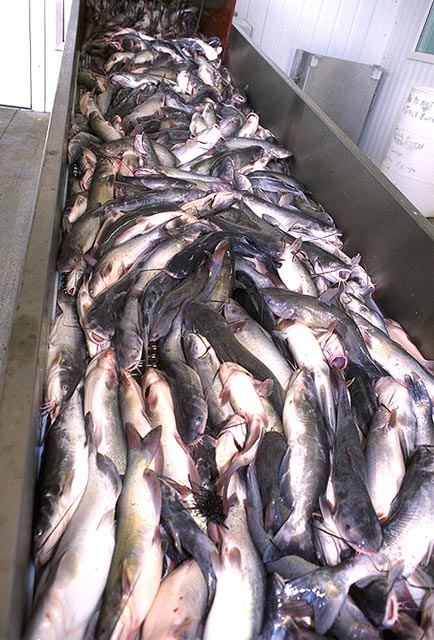
The 2008 farm bill requires the USDA to take over Food and Drug Administration (FDA) inspections of both domestic and imported catfish. Already extremely tardy to take the inspections on, the USDA must first define exactly what it will be inspecting.
For more, see catfish inspections
Last Friday (Feb. 18), the department said it was considering two options for the definition of ‘catfish’ and will be seeking public comment through late June. Option one: proclaiming ‘catfish’ as all species in the Siluriformes order (including the Pangasiidae, Clariidae and Ictaluridae families). Option two: placing all species in the family Ictaluridae under the ‘catfish’ umbrella.
Another proposal says the USDA will require marks of inspection from its Food Safety and Inspection Service (FSIS) or the equivalent from a catfish exporting nation. If implemented, this would require Asian aquaculture operations to overhaul current unclean and/or unsafe farming practices.
For more, see catfish farming
On Monday, Delta Farm Press spoke with Joey Lowery, a Newport, Ark., catfish producer and Catfish Farmers of America (CFA) president. Among his comments:
On the USDA proposal…
“The rule is to be published on Wednesday (Feb. 23). But it was out for public view last Friday. So, it’s moving forward.
“As far as the definition of ‘catfish,’ they’ve left it neutral. They’ve provided two options. One is the narrow definition. The other option is a broad definition, which would take in all Siluriformes– and that’s what we’re advocating.
“Regardless, that will be debated over the comment period before they make a final decision on the definition. We’ll know what will be inspected after that.”
Are you pleased overall?
“I’m pleased the process is moving forward. I was a bit disappointed they didn’t go ahead and just use the broad definition of ‘catfish.’ I think the USDA and FSIS know that in order for this rule to achieve food safety – what it’s there for – you have to go with the broad definition.
“In my correspondence with Agriculture Secretary (Tom) Vilsack through letters, he’s made the comment that if the main intent of the rule is to maximize food safety, you’d have to use the broad definition.
“Why they didn’t go ahead and put that out, I don’t know. I guess there are some other people (involved in the process) that feel differently. But, deep down, the FSIS knows what needs to be done.”
Asian complaints
Have you heard any complaints from Asian exporters about this yet?
“I haven’t heard yet – but it’s a little early. I haven’t heard an official response.
“They know they’ve been under a lot of scrutiny in the last year. Yet, I saw where 47 shipments of fish were turned down in 2010. So, I guess even though they’re under so much scrutiny, they haven’t fully cleaned up their act yet.”
Is CFA encouraging people to comment?
“We’ll have 120-day comment period and people need to write letters. It’s very important that people let USDA know what they think about this. Hopefully, there will be overwhelming response to make this happen.
“I’m confident that consumer groups are on board with this.
“The only opposition I can see is the importers. Everyone else seems to want this to happen.”
Note: comments may be submitted at www.regulations.gov, e-mailed to [email protected], or sent by mail to the U.S. Department of Agriculture, FSIS Docket Clerk, Room 2-2127, George Washington Carver Center, 5601 Sunnyside Ave., Mailstop 5272, Beltsville, Md. 20705.
On when a final rule may finally be set in stone…
“Well, there’s a 120-day comment period. Then, it usually takes about 30 days to come out with a final rule. But if they’re still having trouble making their minds up, they can take 90 days.
“Then, there’s an implementation phase. So, I think we’re looking at sometime in 2012 before the rule is actually working for us.”
On the coming cropping season and high grain prices…
“The high price of grain has a direct impact on our feed costs. It will make it more expensive to raise fish.
“About every $10 extra you spend per ton of feed, on average, adds about a penny per pound in production costs. And it doesn’t look like there’s a lot of relief ahead for corn and soybeans prices.
“That’s especially true with cotton prices up so high. All the crops are going to be fighting for acres. Instead of going with corn, I figure cotton will be planted on cotton land, this year.”
About the Author(s)
You May Also Like




